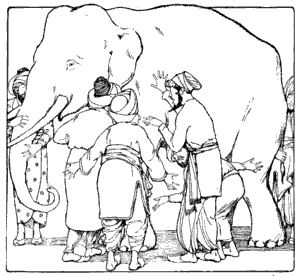
Maybe you know the story of the blind men and an elephant. (Proving yet again that everything is a remix, there are many different versions of it in several different cultures.)
For the uninitiated, it usually goes like this: some blind men come across an elephant, only being blind they can’t tell that it’s an elephant.
“It’s the elephant in the room!”
Nope, that’s a different analogy. Far from ignoring it, as one would the proverbial one in the room, each blind man goes and bravely touches one part of the mystery object, in order to find out what it is.
One touches the tail, and decides that it must be a rope. Another touches the legs, and identifies a pillar. And so on and so forth, via the winnowing basket ears and the wall-like belly. The details vary between each variation – the important thing is that each man comes away with an entirely different, and equally wrong, idea of what the elephant is.
Facebook is that elephant.
Here are some choice descriptions of Facebook from Paul Ford’s piece “Facebook and Instagram: When Your Favorite App Sells Out”:
[…] Facebook is a sprawling, intertextual garden of forking pokes […]
In terms of user experience […], Facebook is […] a chaotic mess of products designed to burrow into every facet of your life.
That’s Facebook, and that’s where the difficulty lies in understanding Facebook. It’s different things to different people. Is it for toddlers or older people? It an instant messaging service, or something like Friends Reunited? Is it a blog engine, a microblogging site, or for sharing photographs or videos? Is it a business directory? A means of recording one’s marital status? A social bookmarking tool?
Of course, it’s all of those things – and more. Above all, we mustn’t lose sight of the fact that it’s a for-profit company, a means of farting money towards its owners, and that advertising is a bit uncomfortable. Nothing revolutionary about those notions.
And now, as has been widely reported, another thing that it is – or at least, that it owns – is a means of making usually inane digital photographs look all strange, and sharing them with one’s followers. What enormous pricks! But of course, I wish them all the very best.
Let me zoom in some more on some of Paul Ford’s article:
[Facebook] is also technologically weird. For example, much of the code that runs the site is written in a horrible computer language called PHP, which stands for nothing you care about. Millions of websites are built with PHP, because it works and it’s cheap to run, but PHP is a programming language like scrapple is a meat. Imagine eating two pounds of scrapple every day for the rest of your life — that’s what Facebook does, programming-wise. Which is just to say that Facebook has its own way of doing things that looks very suspect from the outside world — but man, does it work.
As others have must have also twigged by now, what a coincidence that this should coincide with someone elses’s epic “PHP: a fractal of bad design”. Pretty damming stuff, all, and now I am rethinking a lot of my life choices. (I have bought a new technical book, and I will be disappointed if none of the assertions ring true.)
(Elephants are probably better-, uh, designed than both PHP and Facebook.)